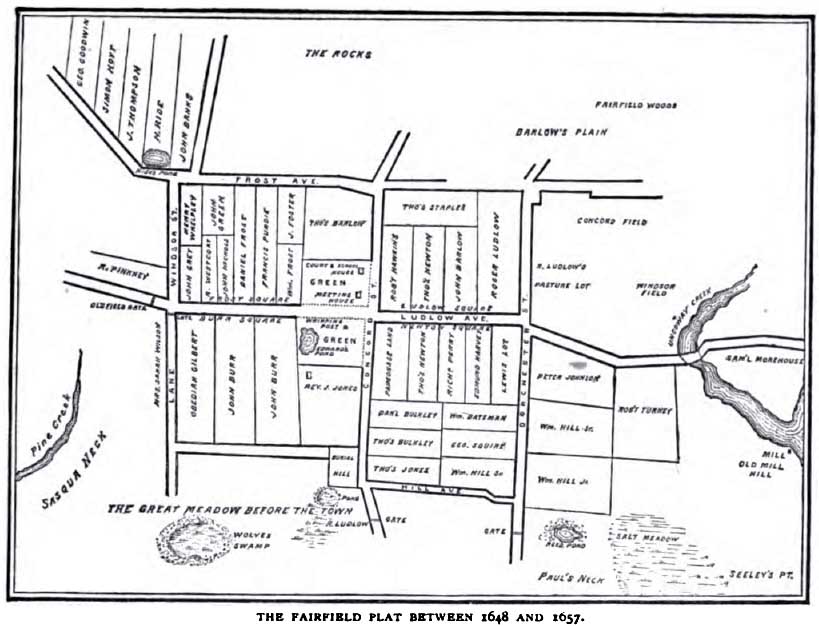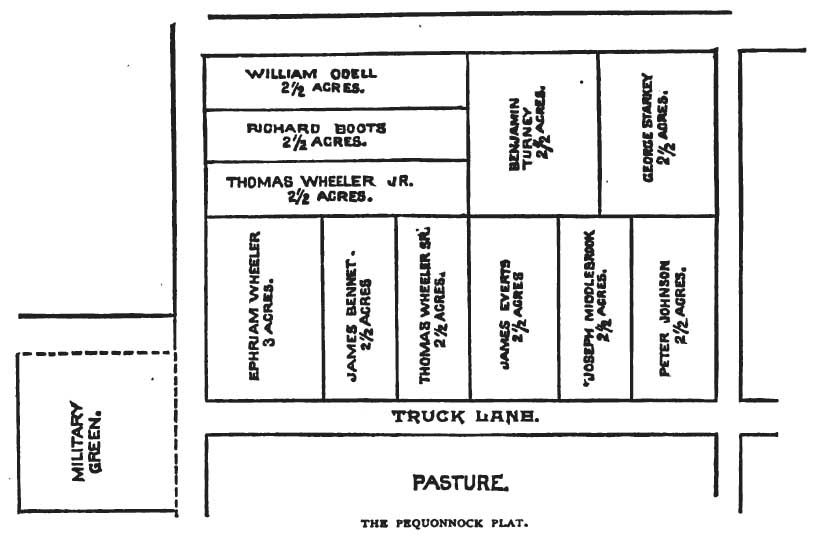| CHAPTER
II. - |
1650 -
1660 - WARS AND RUMORS OF WARS |
64 |
| |
- Original plats of
Fairfield and Pequonnock
- Planters and heads of families
- Assistant and deputies of 1650
- General laws
- Election sermons
- Ludlow a commissioner
- Witchcraft
- Trial and execution of Goodwife Knap
- War between England and Holland
- Trouble with Indians
- Dutch vessel seized
- Supposed plot of the Dutch and Indians
- Fears of a general massacre
- Preparations for war
- England sends arms and ammunition
- Ludlow chief military officer
- Pirates
- Commissioners at Boston
- Agents sent to England for assistance
- Preparations at New Amsterdam
- Severity of colonial laws
- Invitation to Charles II. to come to America
- Oliver Cromwell Lord Protector of England
- John Underhill
- Two Dutch war vessels enter Black Rock harbor.
- Death of Governor Haynes
- A fast
- Fairfield declares war against the Dutch
- Ludlow leaves the country
- His detention by New Haven
- Sails for Virginia
- English fleet arrives at Boston
- Peace proclaimed between England and Holland
- War declared against the Indians
- Six men to join the army from Fairfield
- General training day
- List of estates
- General Thanksgiving
- Major Willard's course
- Pequots awarded land
- Care of arms and ammunition
- Trouble with the Indians
- Pits for wolves
- Military laws for Indians
- Games
- Lotteries
- Town limits extended
- Efforts to pacify
- Indians
- General fast
- Great morality
- Probate Judges
- Colony tax
- Custom-house duties
- Temperance laws
- Commissioners
- Law for magistrates
- Thanksgiving |
|
HAVING
traced the principal events of the first decade of
the settlement of Fairfield, the opening of the year
1650 introduces us to the early land records of the
town. Whatever of value was contained in the
first thirteen pages of "Letter A of Town Deeds" has
been lost; but the following pages afford clues of
the original plats of Fairfield and Pequonnock,
which the diagrams represent between 1648 and 1654,
with the names of the settlers who occupied
them during the period.
The movement of the Bankside farmers resulted in the
sale of their home-lots in Fairfield. This is
recorded on the thirteenth page of Letter A of Town
Deeds, where we learn that John Banks, who
had previously lived east of Hide's pond, and
sold his house and home-lot to Humphrey Hide,
on the 12th of May, 1650, purchased Daniel Frost's
house and home-lot, consisting of three and
three-fourths acres. On the 4th of March,
1650, Simon Hoyt, of Stamford, who had been
granted a home-lot west of Hide's Pond, between
John Thompson's and George Goodwin's
purchased John Green's house and home-lot.
The sale of Thomas Newton's, on the Ludlow
and Newton squares, are not recorded
until 1653, at which time

they were sold by Alexander Bryan,
a lawyer and real estate agent, of Milford.
The same year the one on the Ludlow square
was purchased of Bryan by Andrew Ward
(who had previously purchased John Thompson's
home-lot, west of Hide's Pond), while his
place on the Newton square was occupied by
Nathan Gold, who removed from Milford in 1649,
and first occupied John Foster's lot in the
Frost square. Gold's
purchase of this place was not recorded until the
5th of December, 1653, he having previously sold it
to Thomas Sherwood. Soon after
purchasing Thomas Newton's lot,
Nathan Gold purchased the lot next above
it first granted to Richard Perry in 1649,
and he sold the Newton lot to Dr. Thomas
Pell. Henry Gray left the Frost
homestead, the use of which, by William Frost's
will, was given to him and his wife during their
lives, and entailed to their son, Jacob Gray,
and he also became one of the Bankside farmers.
The house and home-lot of John Gray, who appears
to have settled at Newtown, Long Island, was
purchased by Bryan and sold on the 18th of
March, 1649, to Henry Rowland. Richard
Westcoat, who had owned the house and home-lot
between John Gray's and John Nichol's
died soon after he settled in Fairfield. His
widow married Nathaniel Baldwin, of Milford.

Baldwin removed to Fairfield,
and by virtue of his marriage occupied the dwelling
and lands of Westcoat. The widow of
William Hill, sr., whose husband had first been
granted a home-lot on the north-east side of
Dorchester street, is recorded in 1649 as living on
the northwest corner of Newton square.* It was
not an unusual thing for the planters to receive
grants of home-lots, and also hold others purchased
or exchanged.
The Purdy lot was sold to Moses Dimond
May 2, 1670, at which time John Purdy, son of
Francis Purdy, deceased, lived at
Eastchester. The Frost lot was owned by
Jacob Gray until 1886, when it was purchased
by the Rev. Samuel Wakeman for his son
Samuel, and deeded to him the 6th of November of
that year.
Henry Welpley sold his lot to Alexander Bryan,
who resold it to Alexander Knowles 17th
January, 1653. Feb. 9, 1653, Dr. Thomas
Pell purchased Nathan Gold's house and
home-lot next the parsonage land. Dec. 8,
1653, Nathan Gold purchased Richard Perry's
home-lot, which was afterwards sold to Dr.
William Ward. The Lewis lot was
granted by the town to William Hill, sr.,
Feb. 13, 1670. Jehu Burr, jr's
land is not recorded until 1670. After
his father's death he purchased of his brother,
John Burr, the home-lot on the west, next to
Obediah Gilbert's, and John Burr
purchased the Pinkney lot opposite John
Gray's. The Hoyt lot was sold to
Andrew Ward, then to Edward Adams, next
to William Hayden, and in 1666 to Francis
Bradly.
MORE TO COME....
Among the other early Pequonnock settlers was
Samuel Gregory, who lived near the foot of
Golden-hill, near the street which crosses the hill
to Stratford. A few rods east of the military
park were some three acres of peat swamp land, which
was used as fuel. A stone quarry lay but a few
rods north-east of this peat land; and about a mile
to the north was still another quarry. West of
the military green was the first burial ground of
Pequonnock;/ but it does appear that it was used for
this purpose until some years after the settlement,
when by a vote of the town the Pequonnock planters
were granted a burial place. In addition to
the above mentioned names the following list gives
the heads of other families living in Fairfield
between 1639 and 1650:
John Cable
John Chapman
James Beers
Widow Rachel Brundish
Thomas Demond, or Dimond
Thomas Dickerson
Thomas Dunn
Samuel Drake
George Goodwin |
George Hull
Cornelius Hull
Stephen Hedge
Timothy Hoard
Richard Knowles
Richard Lyon
Richard Lockwood
Thomas Mayocke
Nehemaiah Olmstead |
John Tompkins
John Thompson
Charles Tainter
Mrs. Jane Stalion (Sterling)
Thomas Sherwington
Robert Wolly
Antony Wilson
John Whitlock |
There were
probably others, but those only have been given
which could be obtained with certainty. The
list of land-holders between 1650 and 1700 who did
not share in the land dividends of the town, were as
follows:
Samuel Allin
Gideon Allen
John Alllyn
Thomas Baxter
Robert Bisbum
Thomas Bedient
John Beardsley
Thomas Barnum
Richard Burgis
Joseph Bastard, or Barstow
John Crow
William Cross
Robert Churchill
Henry Castle
John Crump
John Campbell
Henry Crane
John Edwards
John Eggleston
Albert Dennie
John Davis
Elias Doughty
John Darling |
Thomas Disborow
John Down
Moses Demont, or Dimond
Jonathan Fanton
Luke Guire, or Weire
Christopher Godfree
Philip Galpin
William Hayden
John Herdman
Thomas Hurlburt
Esborn Wakeman
Elnathan Handford
Joseph James
Samuel Judson
Henry Lyon
Walter Lancaster
Robert Lord
Lewis Phillips
John Mills
Thomas Merwin
Peter Mayoke
John Mahew
|
Dongal Mac
Kensey
Antony Nouguier
Nehemiah Olmstead
John Plastead
John Platt
John Palmer
Joseph Phippen
Samuel Robinson
John Read
Elisha Risden
John Ufford
John Sorserer
Samuel Summers
Samuel Smedley
Samuel Sherman
John Thorp
John Winters
Thomas Williams
Nathaniel White
Richard Vowles, or Fowles
Philip Vicars
Thomas Yeow |
The
soldiers engaged in the Pequot war of 1637 and 1638,
who settled at Fairfield, were:
Roger Ludlow
Dr. Thomas Pell**
James Eggleston
Nehemiah Omstead |
William Hayden
Thomas Lyon †
Samuel Gregory |
Thomas Basset
John Wood
Richard Osborn |
MUCH MORE TO COME....